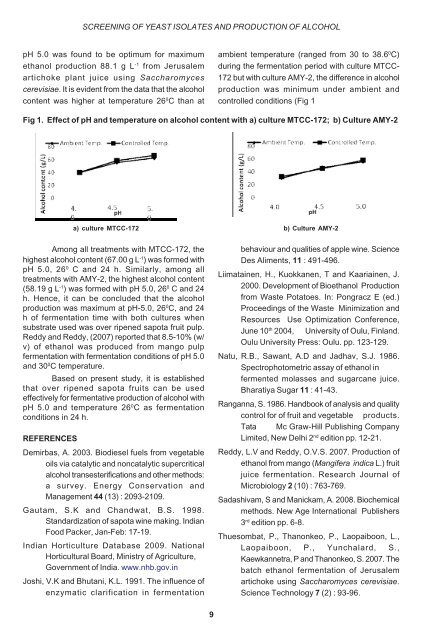physicochemical
Contents of 39(1 & 2) 2011 - acharya ng ranga agricultural university
Contents of 39(1 & 2) 2011 - acharya ng ranga agricultural university
- No tags were found...
You also want an ePaper? Increase the reach of your titles
YUMPU automatically turns print PDFs into web optimized ePapers that Google loves.
SCREENING OF YEAST ISOLATES AND PRODUCTION OF ALCOHOL<br />
pH 5.0 was found to be optimum for maximum<br />
ethanol production 88.1 g L -1 from Jerusalem<br />
artichoke plant juice using Saccharomyces<br />
cerevisiae. It is evident from the data that the alcohol<br />
content was higher at temperature 26 0 C than at<br />
ambient temperature (ranged from 30 to 38.6 0 C)<br />
during the fermentation period with culture MTCC-<br />
172 but with culture AMY-2, the difference in alcohol<br />
production was minimum under ambient and<br />
controlled conditions (Fig 1<br />
Fig 1. Effect of pH and temperature on alcohol content with a) culture MTCC-172; b) Culture AMY-2<br />
a) culture MTCC-172 b) Culture AMY-2<br />
Among all treatments with MTCC-172, the<br />
highest alcohol content (67.00 g L -1 ) was formed with<br />
pH 5.0, 26 0 C and 24 h. Similarly, among all<br />
treatments with AMY-2, the highest alcohol content<br />
(58.19 g L -1 ) was formed with pH 5.0, 26 0 C and 24<br />
h. Hence, it can be concluded that the alcohol<br />
production was maximum at pH-5.0, 26 0 C, and 24<br />
h of fermentation time with both cultures when<br />
substrate used was over ripened sapota fruit pulp.<br />
Reddy and Reddy, (2007) reported that 8.5-10% (w/<br />
v) of ethanol was produced from mango pulp<br />
fermentation with fermentation conditions of pH 5.0<br />
and 30 0 C temperature.<br />
Based on present study, it is established<br />
that over ripened sapota fruits can be used<br />
effectively for fermentative production of alcohol with<br />
pH 5.0 and temperature 26 0 C as fermentation<br />
conditions in 24 h.<br />
REFERENCES<br />
Demirbas, A. 2003. Biodiesel fuels from vegetable<br />
oils via catalytic and noncatalytic supercritical<br />
alcohol transesterifications and other methods:<br />
a survey. Energy Conservation and<br />
Management 44 (13) : 2093-2109.<br />
Gautam, S.K and Chandwat, B.S. 1998.<br />
Standardization of sapota wine making. Indian<br />
Food Packer, Jan-Feb: 17-19.<br />
Indian Horticulture Database 2009. National<br />
Horticultural Board, Ministry of Agriculture,<br />
Government of India. www.nhb.gov.in<br />
Joshi, V.K and Bhutani, K.L. 1991. The influence of<br />
enzymatic clarification in fermentation<br />
behaviour and qualities of apple wine. Science<br />
Des Aliments, 11 : 491-496.<br />
Liimatainen, H., Kuokkanen, T and Kaariainen, J.<br />
2000. Development of Bioethanol Production<br />
from Waste Potatoes. In: Pongracz E (ed.)<br />
Proceedings of the Waste Minimization and<br />
Resources Use Optimization Conference,<br />
June 10 th 2004, University of Oulu, Finland.<br />
Oulu University Press: Oulu. pp. 123-129.<br />
Natu, R.B., Sawant, A.D and Jadhav, S.J. 1986.<br />
Spectrophotometric assay of ethanol in<br />
fermented molasses and sugarcane juice.<br />
Bharatiya Sugar 11 : 41-43.<br />
Ranganna, S. 1986. Handbook of analysis and quality<br />
control for of fruit and vegetable products.<br />
Tata Mc Graw-Hill Publishing Company<br />
Limited, New Delhi 2 nd edition pp. 12-21.<br />
Reddy, L.V and Reddy, O.V.S. 2007. Production of<br />
ethanol from mango (Mangifera indica L.) fruit<br />
juice fermentation. Research Journal of<br />
Microbiology 2 (10) : 763-769.<br />
Sadashivam, S and Manickam, A. 2008. Biochemical<br />
methods. New Age International Publishers<br />
3 rd edition pp. 6-8.<br />
Thuesombat, P., Thanonkeo, P., Laopaiboon, L.,<br />
Laopaiboon, P., Yunchalard, S.,<br />
Kaewkannetra, P and Thanonkeo, S. 2007. The<br />
batch ethanol fermentation of Jerusalem<br />
artichoke using Saccharomyces cerevisiae.<br />
Science Technology 7 (2) : 93-96.<br />
9
















